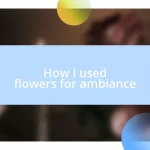Key takeaways:
- Incorporating herbs into floral bouquets enhances aesthetics and adds meaningful symbolism, such as rosemary representing remembrance.
- Choosing herbs based on their scent, color, and associated emotions creates layers of texture and storytelling within arrangements.
- Caring for herbal arrangements, including regular hydration and humidity maintenance, significantly prolongs their freshness and visual appeal.

Herbs for floral bouquets
When I first started incorporating herbs into my floral bouquets, I was amazed by the subtle yet profound impact they had on the overall aesthetic and scent. Imagine the fresh aroma of basil mingling with roses; it creates a sensory experience that elevates the bouquet beyond just visual appeal. Don’t you think the fragrance can transport you to a sunlit herb garden?
A particularly memorable moment was when I crafted a bouquet for a friend’s wedding, using rosemary as a central herb. It wasn’t just for looks; I chose rosemary because it symbolizes remembrance—a beautiful sentiment for such a special occasion. Seeing her emotional reaction as she held the bouquet made me realize how herbs can convey deeper meanings and provide a tangible connection between nature and our experiences.
I often find myself experimenting with different herbs, like mint or dill, which not only add distinct scents but also interesting textures. Have you ever considered how the visual contrasts can enhance a bouquet’s overall design? The way mint’s bright green leaves contrast with vibrant flowers is simply delightful. Each herb offers its own unique charm and story, so why not let them play a starring role in your next bouquet?

Choosing the right herbs
Choosing the right herbs can be a delightful yet challenging task. Personally, I enjoy selecting herbs based on their scent, color, and the emotions they evoke. For instance, using lavender not only imparts a calming fragrance but also creates a visual softness that perfectly complements more vibrant flowers like sunflowers. Each herb tells a story, and it’s essential to discern how it fits into the narrative of your bouquet.
I’ve found that pairing herbs with specific flowers can elevate the overall design. When I chose thyme to accompany bright gerbera daisies in a recent arrangement, the earthy tones of thyme balanced the boldness of the daisies beautifully. This blend isn’t just about aesthetics; it’s about creating layers of scent and texture that invite people to engage more deeply with the bouquet.
In my experience, considering how herbs symbolize different sentiments can guide your choices as well. For example, dill represents feasting and celebration, making it a great addition to bouquets for joyous occasions. I remember crafting a bouquet for a family gathering and incorporating dill; not only did it look attractive, but it also sparked conversations about cherished memories of past gatherings. It’s these personal connections that can make your selection of herbs feel truly special.
| Herb | Characteristics |
|---|---|
| Basil | Fresh aroma, bright green leaves; great paired with roses |
| Rosemary | Strong fragrance, symbolizes remembrance; ideal for sentimental occasions |
| Mint | Refreshing scent, vibrant color; adds a lively contrast |
| Thyme | Earthy aroma, small leaves; pairs well with bold flowers like gerbera daisies |
| Dill | Distinctive scent, feathery appearance; perfect for celebratory bouquets |

Preparing herbs for arrangements
When preparing herbs for arrangements, I find it crucial to start with fresh, vibrant plants. The liveliness of the herbs not only enhances the bouquet’s appearance but also keeps the scents lively. After washing the herbs gently, I trim the stems at an angle to maximize water absorption, ensuring they stay hydrated longer.
- Select herbs that complement your floral choices.
- Wash herbs gently to remove any dirt or insects.
- Trim stems at an angle for better hydration.
- Remove lower leaves to prevent rot in the water.
I remember a time when I included sage in a rustic-themed bouquet. Its silvery-green leaves had an earthy feel that connected beautifully with the wildflowers and grasses I used. I also like to bruise the leaves slightly before placing them in the arrangement; this technique releases essential oils that heighten the fragrance, creating a multi-sensory experience for anyone lucky enough to be near it. There’s something satisfying about knowing that these carefully prepared herbs will exude not just beauty, but lasting memory, enriching the atmosphere around them.

Mixing herbs with flowers
Mixing herbs with flowers is an art form that really speaks to me. Each time I create a bouquet, I think about how the textures and scents blend together. Last summer, I experimented with mint and peonies, and I was pleasantly surprised by how the refreshing scent of mint popped against the delicate perfume of peonies. It made me wonder: how often do we overlook the subtle ways we can enhance our floral arrangements?
I also cherish the memories tied to specific herb and flower combinations. For instance, including rosemary with lilacs in a wedding bouquet was an emotional choice for me. The deep green of rosemary, known for its symbolism of remembrance, paired wonderfully with the soft purple of lilacs, evoking nostalgia and love in a heartfelt way. Isn’t it fascinating how a single herb can transform the emotional resonance of flowers?
There’s something deeply fulfilling about discovering unexpected combinations. One time, I added chamomile to a summer arrangement of daisies and sunflowers. The tiny, white chamomile flowers provided a whimsical touch, almost like tiny stars among their larger counterparts. I honestly believe mixing herbs with flowers adds a layer of vibrancy and storytelling that we all can appreciate. Why not try it yourself—what story will your bouquet tell?

Techniques for long-lasting bouquets
When it comes to ensuring your bouquets last as long as possible, one technique I’ve found quite effective is using a mixture of water and flower food. This combination provides vital nutrients to the blooms while keeping the pH balanced, which helps prevent bacteria growth. I remember a time when I made a bouquet for a friend’s birthday; I added a bit of sugar to the water. The result was remarkable—her flowers thrived far longer than I expected!
Another critical aspect of prolonging a bouquet’s life is choosing the right vase. I prefer using a narrow-necked vase, which helps limit the number of stems in the water, reducing the chances of bacterial growth. It’s surprising how a simple choice like this can have such a significant impact. Have you ever noticed how certain flowers appear to drink more than others? It’s fascinating to observe how some blossoms thrive better when their environment is tailored to their needs.
Lastly, I make it a point to change the water every few days and recut the stems. This routine helps maintain hydration and prolong the freshness of the arrangement. I vividly recall a time when I forgot this step—my beautiful arrangement wilted faster than I anticipated. It was a hard lesson learned, reminding me how even small maintenance tasks can make all the difference in enjoying long-lasting beauty. How often do we take for granted the upkeep that flowers truly deserve?

Displaying herb-infused bouquets
Displaying herb-infused bouquets can be a delightful experience. I remember visiting a friend’s home where she elegantly arranged her herb bouquets on the dining table. The rosemary and sage added an earthy element that brought the entire space to life. The colors and scents blended seamlessly, creating an inviting atmosphere for dinner conversations. Have you ever thought about how much of an impact a simple bouquet can have on the mood of a room?
One of my favorite ways to present these bouquets is by pairing them with rustic pottery or mason jars. The natural textures of the containers really complement the herbal elements. I once used a vintage tin to hold a mixed bouquet of lavender and basil, and it turned out beautifully. The tin’s patina not only added character but also sparked conversations about its history when guests inquired. How exciting is it to provoke thoughts and stories just with the right choice of display?
I also like to change the display method based on the season. For instance, during autumn, I incorporate herbs like oregano and thyme with more vibrant flowers. This creates a warm palette that mirrors the colors of fall. Each time I create a new arrangement, I feel a connection to the changing seasons, reminding me of nature’s rhythm. What mood or season do you want your bouquet to evoke?

Caring for herbal arrangements
Caring for herbal arrangements is an art that truly enhances both the flowers and our experience with them. I’ve learned that placing the herbs in water can significantly prolong their freshness, but I also love to mist them with a little water daily. It’s like giving the herbs a refreshing drink and a gentle hug at the same time. Have you ever noticed how your mood uplifts with just a little care and attention?
In my experience, maintaining humidity in the air around the bouquet can make a noticeable difference. I’ve positioned my herbal arrangements near a small humidifier, and it worked wonders, particularly during dry winter months. Watching them thrive filled me with a sense of gratitude; it reminded me how nurturing the environment yielded such vibrant results. Doesn’t it feel great to know we can contribute to our plants’ well-being in such a simple way?
Lastly, I think about how herbs can dry out faster than traditional flowers. To combat this, I always trim the leaves that submerge in the water—this minimizes rot and keeps the arrangement looking its best. A memorable moment was when I neglected this step, and the rosemary started looking limp. I immediately knew I had to act, and as soon as I trimmed it, the freshness returned. It’s a powerful reminder that small adjustments can lead to significant changes, wouldn’t you agree?














